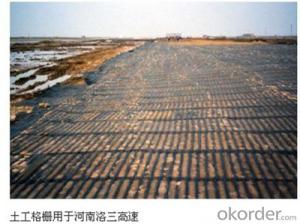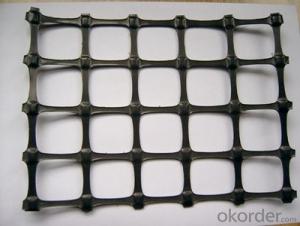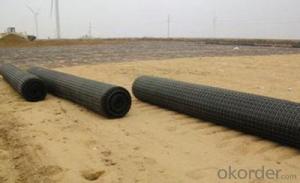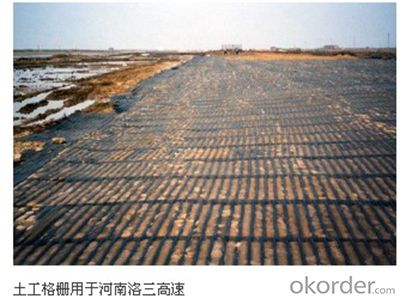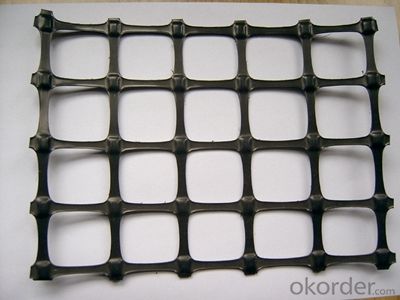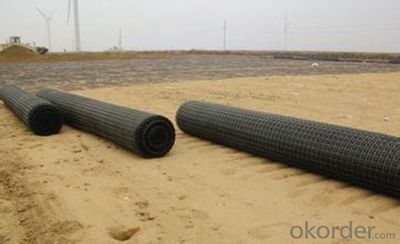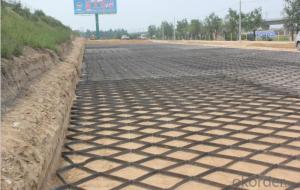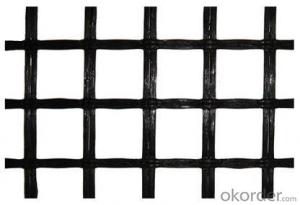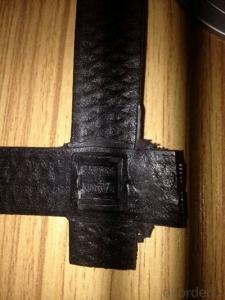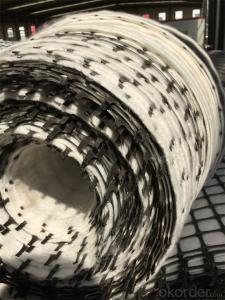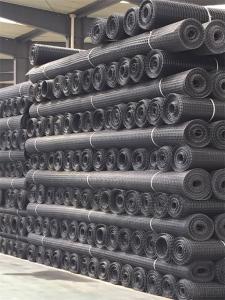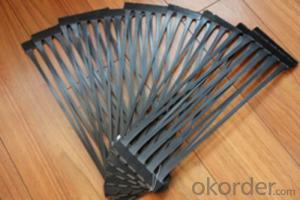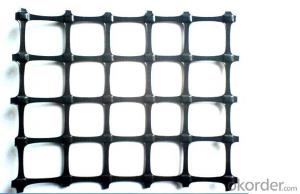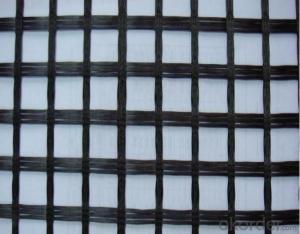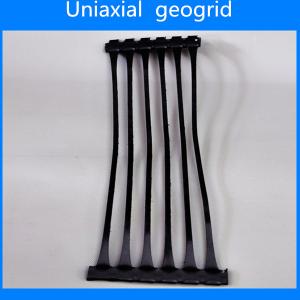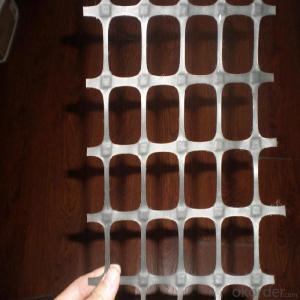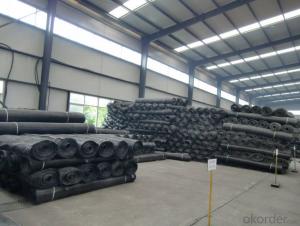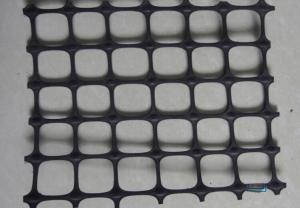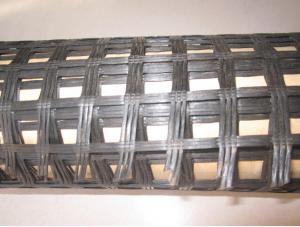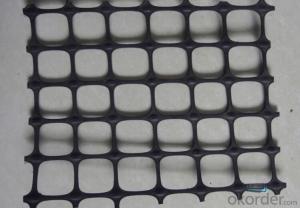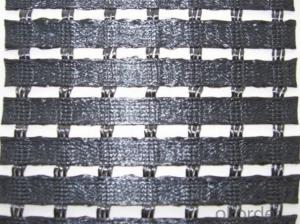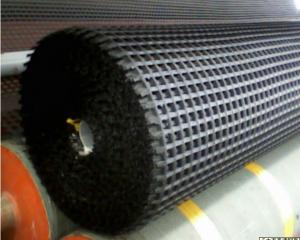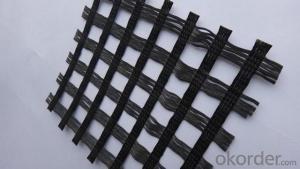Geocells for Erosion Control - Uniaxial Plastic Geogrid CE Certificate Good Quality
- Loading Port:
- Tianjin
- Payment Terms:
- TT OR LC
- Min Order Qty:
- 888 m²
- Supply Capability:
- 1800000 m²/month
OKorder Service Pledge
OKorder Financial Service
You Might Also Like
1.Structure of Uniaxial Plastic Geogrid descriptions:
It is is a smooth high density proethylene(HDPE) Geogrid manufactured with the highest quality . This product is used in applications that require excellent chemical resisitance and endurance properties.

Features of Uniaxial plastic Geogrid :
High strength , Good flexibility, anti-aging, resisting acid and Alkaline.
Usage of Uniaxial Plastic Geogrid :
Make reinforcement for various kinds of soil foundation enhance and improve bearing ability if the roadbed .make reinforcement for retaining wall, steep slope, dam and bridge abutment under stress status for long term thus to improve quality and prolong service life of the project .
Specification of the Uniaxial Geogrid
TGDG35 TGDG50 TGDG80 TGDG110 TGDG120
Width : <= 2.5m
Length : 50—100m
Color : black
Packaging : Each roll is wrapped in a woven bag then into container Or Packed as customers' requests.
Production periods: within 15 days after receiving the deposit
Introduction of CNBM
China National Building Materials (Group) Corporation (CNBM) is a state-owned enterprise in charge of administrative affairs in China building materials industry. Established in 1984, CNBM is a large group corporation of building materials with total assets of RMB 25 billion and a total staff of 30,000. Now CNBM owns more than 200 subsidiaries in and abroad the country, including wholly-owned corporations and joint ventures.
FAQ of geosynthetics :
What is geosynthetics ?
Geosynthetics form a perfect erosion control fabric used extremely widely in civil engineering to stabilize and reinforce slopes and soil under or next to roads, railways, dams, water reservoirs etc.. They can be easily applied which minimizes the time of construction, as well as they limit the resources and materials necessary.
What kinds of geosynthetics we have ?
Non-woven geotextile, geogrids, geocells, GCL, Geomembranes, Geonets, Geocomposites etc .
What is the geosynthetics used for ?
Hydraulic
Lagooning and Water Treatment, Ornamental Ponds, Golf Courses
Aquaculture and Desalination,Water Lagoons,Tanks, Reservoirs, Liquid Waste,Floating Cover Solutions, Drainage and Filtration
Environment
Tailing ponds, Leach mining,Landfills,Landfill Capping,Protection against corrosion,Vertical Barriers
Civil Works
Erosion Control,Secondary Containment,Tunnels,Linear and Surface Works,Consolidation of Margins,Soil Reinforcement,Soil Separation.
Building - Parkings,Roofing,Soundproofing
- Q: Geogrid manufacturers and the price is how much?
- Product features: uniaxial geogrid is a kind of polymer as the main raw material, adding anti UV, anti aging agent must, after the original tensile distribution chain shaped molecules scattered re aligned linear, pressure into a sheet by extrusion and punching network rules, high strength and geotextile material the longitudinal stretch into the.
- Q: How are geogrids installed in construction projects?
- Geogrids are typically installed in construction projects by first preparing the ground surface and ensuring it is compacted and leveled. The geogrid is then laid out on the prepared surface and secured in place using stakes or anchor systems. It is important to ensure that the geogrid is properly tensioned and aligned to provide maximum stability and reinforcement. Finally, the geogrid is covered with additional layers of soil or other construction materials to complete the installation.
- Q: Are geogrids suitable for use in soft soils?
- Yes, geogrids are suitable for use in soft soils. Geogrids provide reinforcement to the soil, improving its stability and load-bearing capacity. They are particularly effective in soft soils as they distribute the load more evenly, reducing the risk of settlement and soil movement. Additionally, geogrids can help prevent lateral spreading and improve the overall performance of structures built on soft soils.
- Q: Can geogrids be used in load transfer platforms?
- Yes, geogrids can be used in load transfer platforms. Geogrids are engineered materials that are commonly used in civil engineering applications to reinforce soil, provide stability, and distribute loads. In load transfer platforms, geogrids are employed to enhance the performance of the platform by spreading the load more evenly and reducing the risk of settlement or failure.
- Q: What is the effect of installation damage on geogrid behavior?
- Installation damage can have a significant impact on geogrid behavior. When a geogrid is improperly installed or damaged during installation, its structural integrity and performance may be compromised. This can lead to reduced tensile strength, decreased load-bearing capacity, and potential failure of the geogrid system. Proper installation techniques and careful handling are crucial to ensure the optimal performance and longevity of geogrids.
- Q: What is the typical width of a geogrid roll?
- The typical width of a geogrid roll is usually between 4 to 16 feet.
- Q: How much cheaper than steel reinforced plastic geogrid
- Specifications of different prices, the general specification of 4 to 6.5 square.
- Q: What are the factors that affect the cost-effectiveness of geogrid-reinforced structures?
- There are several factors that can affect the cost-effectiveness of geogrid-reinforced structures. Firstly, the type and quality of the geogrid material used can significantly impact the overall cost. Higher-quality geogrids may initially be more expensive but offer better long-term performance, potentially reducing maintenance and repair costs over time. Additionally, the design and engineering of the structure play a crucial role. Properly designed geogrid-reinforced structures can optimize material usage and minimize construction costs. The expertise and experience of the engineers and contractors involved also contribute to the cost-effectiveness, as their knowledge can help avoid unnecessary expenses and ensure efficient construction. The specific site conditions, such as soil characteristics and slope stability, are also important factors. Geogrids are typically used to enhance soil stability, so the suitability of the soil for reinforcement and the extent of reinforcement required can impact costs. Difficult terrain, challenging access, or the need for additional site preparation can also increase costs. Lastly, the lifespan and durability of geogrid-reinforced structures should be considered. While geogrids are designed to be long-lasting, factors like environmental conditions, loading requirements, and proper installation can affect their performance. Investing in high-quality materials and proper installation methods may initially increase costs but can result in longer service life and reduced maintenance expenses in the long run.
- Q: Are geogrids suitable for reinforcing slope stabilization mats?
- Yes, geogrids are suitable for reinforcing slope stabilization mats. Geogrids are commonly used in conjunction with slope stabilization mats to provide additional strength and stability to the soil. They help distribute loads and prevent soil erosion, making them an effective solution for reinforcing slope stabilization mats.
- Q: Each side of geogrid is not less than 3 meters, what does it mean?
- At present, the largest width of single geogrid is 6 meters
Send your message to us
Geocells for Erosion Control - Uniaxial Plastic Geogrid CE Certificate Good Quality
- Loading Port:
- Tianjin
- Payment Terms:
- TT OR LC
- Min Order Qty:
- 888 m²
- Supply Capability:
- 1800000 m²/month
OKorder Service Pledge
OKorder Financial Service
Similar products
Hot products
Hot Searches
Related keywords
